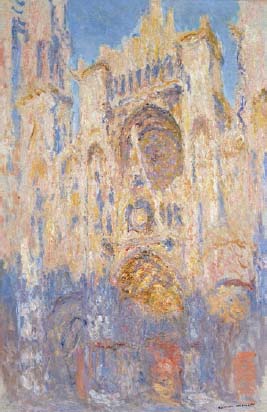From the Industrial Revolution to World War I, C. 1850–1914Impressionism |
Why did Monet paint Rouen Cathedral so many times? |
Monet was fascinated by optical realism and painted multiple (over thirty) canvases 184 of the façade of Rouen Cathedral as an exploration of the properties of ever-changing light and the perception of light by the human eye. Imagine looking across a bright street with squinted eyes, trying to make out the buildings on the other side. With its niches and varied textures, the church fagade was a perfect subject for such experimentation. In the intense sunlight, Rouen Cathedral loses detail and its physicality dissolves. Since the sun is constantly moving through the sky, the light reflecting off the building is constantly changing, and Monet attempted to capture the fleeting quality of this light in his work (which is also responsible for the unfinished style). Monet embraced the aesthetic value of the quick sketch, though he meticulously worked on these pictures in his studio at Giverny, and he hoped to capture this in his series of paintings of Rouen Cathedral.

The Impressionist artist Claude Monet painted Rouen Cathedral many times in an attempt to capture the effect of changing light reflecting off the façade of the building. In Rouen Cathedral in the Afternoon (1894; art courtesy Musée Marmottan Monet, Paris, France / Giraudon / The Bridgeman Art Library.)
